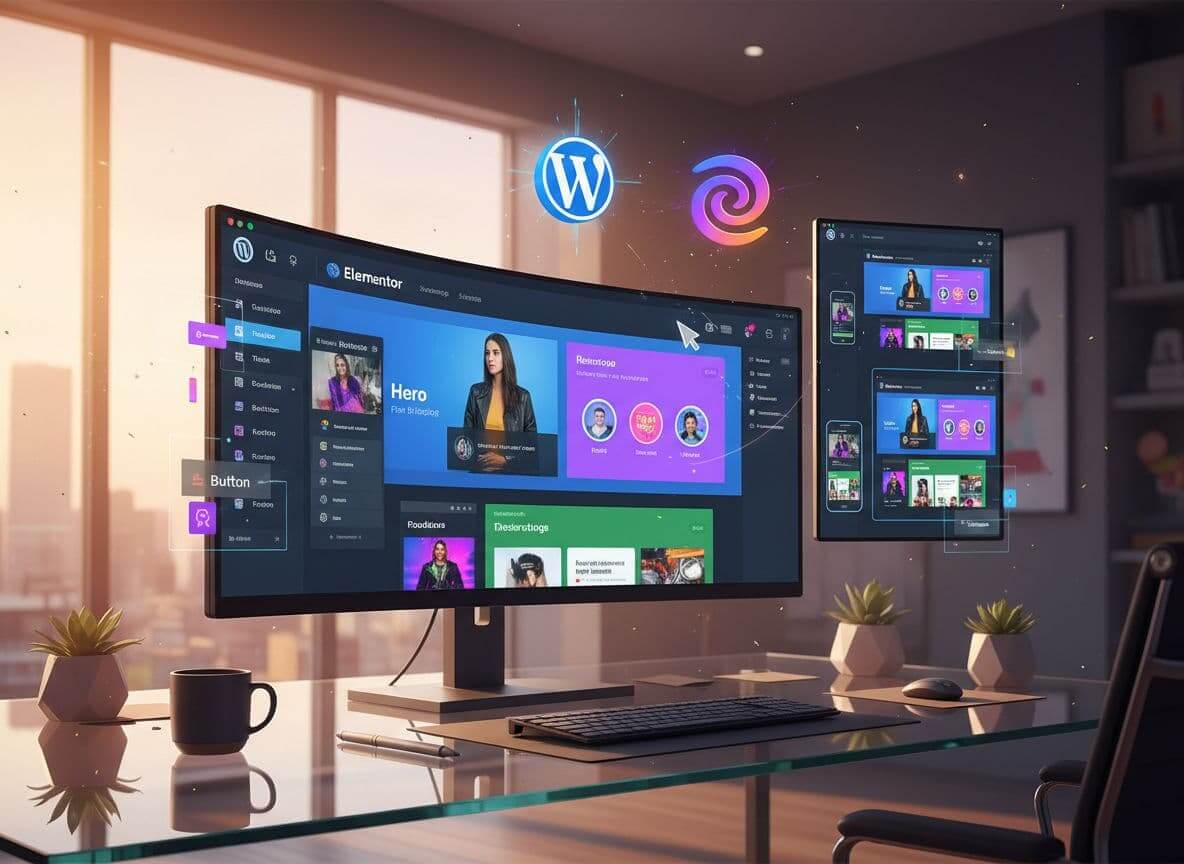Your WooCommerce store looks great in Elementor, but pages still crawl, carts stall, and sales feel stuck. Sound familiar?
In many stores like this, the real bottleneck is not hosting or plugins. It is the theme sitting under WooCommerce and Elementor that quietly slows everything down.
WooCommerce handles products and checkout. Elementor lets you drag and drop custom designs. The theme sits under both and controls layout, styles, and how fast your site actually loads.
This guide compares the most popular lightweight themes for Elementor stores, including Hello Elementor, Astra, GeneratePress, Kadence, and Blocksy. You will see how theme choice affects speed, Core Web Vitals, SEO, and sales, and which type of theme matches your design style and growth plans.
By the end, you will know what to use if you want a blazing fast minimal shop, a template driven store you can launch this week, or a flexible system you can grow for years.
How Theme Choice Affects WooCommerce Speed, SEO, and Sales
Your theme is the foundation of a WooCommerce + Elementor store. Get the base wrong, and everything you stack on top feels slow and clumsy.
At a simple level, the theme controls how heavy each page is, how many files load, and how clean the code looks to browsers and search engines. That feeds straight into user experience, search traffic, and conversion rates.
What a WordPress Theme Actually Does for Your Store
Think of your store as a house.
- WooCommerce is the plumbing and wiring. It runs products, carts, orders, and checkout.
- Elementor is your interior designer. It shapes how each room looks.
- The theme is the frame and walls. It decides basic layout, colors, headers, footers, and how code is loaded.
If the frame is stuffed with extra widgets, sliders, and scripts, every page has to carry that weight. You can buy better hosting or add caching, but a heavy theme will still slow things down.
A light, well built theme gives you a clean frame. Elementor and WooCommerce can do their job without dragging extra baggage on every page load.
Why Speed Matters So Much for WooCommerce Sales
Slow stores lose money. That is blunt, but true.
Each extra second of load time tends to lower conversions. Even a one second delay can drop sales by a few percent. Stretch that across every visit and the loss adds up fast.
Speed hits three key areas:
- Bounce rate; people leave before the page appears.
- Cart abandonment; shoppers give up when cart or checkout hangs.
- Trust; a slow site feels risky, especially when someone is about to type in a credit card.
This pain is sharper on mobile. Most shoppers are on phones, often on shaky networks. They tap a product, stare at a blank screen, and switch to a faster site.
If you care about revenue, you must care about speed. And if you use Elementor, the theme you pick can push you toward a 2 second load or a 6 second wait.
Core Web Vitals, SEO, and Elementor Stores in Simple Terms
Search engines now watch how real users experience your site. Core Web Vitals are at the center of that.
In plain language they measure:
- How fast your content appears.
- How smooth your site feels when you scroll or click.
- How stable the page looks while it loads, without things jumping around.
Lightweight, clean themes often score better straight out of the box. They use smaller files, fewer scripts, and better loading methods.
Elementor adds extra code on top, since every custom section is built with widgets. That is not bad by itself, but it means your base theme must be as lean as possible, or you risk failing Core Web Vitals on mobile.
Pass those checks and you gain better rankings, more search traffic, and a smoother path to checkout.
Theme Types for Elementor WooCommerce Stores: Blank vs All-in-One vs Lightweight Frameworks
Not all themes are built the same. For WooCommerce and Elementor, you can think of three broad types.
- Super minimal blank themes.
- Big multipurpose themes packed with features.
- Modern lightweight frameworks like Astra, GeneratePress, Kadence, and Blocksy.
Each type has tradeoffs in speed, design freedom, and build time.
Blank Canvas Themes (Like Hello Elementor): Maximum Speed, More Work
A blank canvas theme strips everything to the bare minimum. Hello Elementor is the best known example.
You get almost no styling, no complex header builder, and no fancy shop layouts. Elementor handles nearly all visible design.
Pros:
- Very fast, tiny file size.
- Great PageSpeed and Core Web Vitals potential.
- Perfect fit with Elementor, since the same team built it.
- Ideal if you want a fully custom design.
Cons:
- No starter templates for stores.
- You must design headers, footers, product pages, and checkout yourself.
- Easy to overbuild in Elementor and accidentally slow the site.
This type of theme suits agencies, developers, and store owners who work from wireframes, know what they want, and already have good performance habits.
Multipurpose Themes: Lots of Features, Often Slower Stores
Many classic premium themes try to be “one theme for every site.” They pack in sliders, visual effects, shortcodes, page builders, and large demo libraries.
On the surface this looks great. You buy one theme, import a shiny store demo, and start selling.
The problem hits when you stack this theme with WooCommerce and Elementor. Each of these pieces loads scripts and styles. Together they become heavy, especially on category and product pages.
These themes can still work, but to keep them fast you often need:
- Strong hosting.
- Careful trimming of unused modules.
- Extra optimization work.
If you are starting a fresh WooCommerce + Elementor site in 2025, many store owners find it easier to skip these bulky themes and pick a lighter base.
Lightweight Framework Themes: The Middle Ground for Speed and Features
Lightweight frameworks try to hit a sweet spot. They stay fast and lean, but still give you helpful layout controls and WooCommerce features.
Astra, GeneratePress, Kadence, and Blocksy fall in this group.
They usually offer:
- Clean, performance focused code.
- Theme settings for headers, footers, and product layouts.
- Good WooCommerce integration, such as off canvas carts and grid controls.
- Starter templates that work with Elementor.
Used with care, these frameworks make it easier to pass Core Web Vitals while still saving you hours of design time.
The next section looks at each of the big five in more detail.
Theme Showdown: Hello Elementor vs Astra vs GeneratePress vs Kadence vs Blocksy
Here is a quick comparison of how these themes behave with WooCommerce and Elementor in real world tests.
| Theme | Typical Speed & CWV | Best For | Main Tradeoff |
|---|---|---|---|
| Hello Elementor | Very light, high lab scores | Custom Elementor stores, agencies, devs | No styling, more design work |
| Astra | Fast, solid Core Web Vitals | Most small to mid sized stores | Can grow heavier with many add ons |
| GeneratePress | Among the fastest in tests | Speed focused owners, clean layouts | Fewer flashy templates, plain if not styled |
| Kadence | Good speed, rich features | Design heavy brands, WooCommerce power users | More settings can add weight |
| Blocksy | Good speed, modern feel | Block editor fans who still use Elementor | Smaller template library for Elementor |
Hello Elementor: Fastest Blank Canvas for Custom Elementor Shops
Hello Elementor is built by the Elementor team and strips the theme layer to almost nothing.
It loads very small files, often under many popular themes, and can hit PageSpeed scores in the 90s on both mobile and desktop when paired with optimized hosting and careful design. Core Web Vitals like layout shift tend to look great, because the theme does almost nothing on its own.
Pros:
- Very small page size and few requests.
- Perfect technical match with Elementor widgets and templates.
- Great base for pixel perfect custom shops.
Cons:
- No starter store sites.
- You must handle global design inside Elementor.
- Easy to overuse sections and widgets and lose the speed benefits.
Pick Hello Elementor if you treat your store like a design project, have a clear layout plan, and want maximum control over every section.
Astra: Best Balance of Speed, Starter Templates, and WooCommerce Features
Astra is one of the most popular choices for Elementor shops, and for good reason.
It stays light, with page sizes in the same range as other top performers, and can load in under a second in many tests. With basic caching, Astra often hits Core Web Vitals targets for store pages.
Key strengths:
- Large library of Elementor ready shop templates.
- Helpful WooCommerce settings for product grids, checkout, and headers.
- Good mobile layouts out of the box.
Tradeoffs:
- If you install many Astra add ons and third party plugins, page weight goes up.
- Some of the best WooCommerce and layout tools sit in the Pro version.
For most small and mid sized stores that want speed and quick setup, Astra is often the most practical choice.
GeneratePress: Ultra Lightweight Theme for Serious Speed and Clean Code
GeneratePress has a strong reputation with performance focused users.
It keeps file sizes very low and can show load times that beat even Hello Elementor in some tests, with PageSpeed Insights scores in the mid to high 90s when tuned well. Its code is simple and stable, which helps Core Web Vitals and SEO.
Advantages:
- Very small footprint and fast loads, even on shared hosting.
- Clean, consistent layout structure.
- Reliable updates and long term support.
Limitations:
- Fewer bold, design heavy starter sites, especially for WooCommerce.
- Free version feels bare; most advanced options live in the premium plugin.
- Design can look plain unless you spend time styling.
GeneratePress suits store owners who rank speed and stability above visual flair, or agencies that do custom styling anyway.
Kadence: Flexible, Modern Design with Strong WooCommerce Controls
Kadence focuses on giving you a modern look with a lot of control inside the theme panel.
You get visual header and footer builders, strong product and archive controls, and nice presets for colors and typography. Mobile design is a strong point, with good spacing and tap targets.
Upsides:
- Friendly interface and quick setup for good looking stores.
- Rich WooCommerce options without extra plugins.
- Good overall performance and mobile experience when used with care.
Downsides:
- Many design features and toggles can add weight if you enable everything.
- Some powerful tools, like advanced hooks or extra WooCommerce options, need the paid plan.
Kadence fits brands that care about how the store looks, especially on phones, and prefer to adjust many pieces inside the theme instead of relying only on Elementor.
Blocksy: Flexible Theme for Block Editor Fans Who Still Use Elementor
Blocksy is built with the WordPress block editor in mind, but it also plays well with Elementor and WooCommerce.
It offers a modern visual style, dark mode options, and helpful features such as product quick view, off canvas menus, and flexible sidebars. Performance is solid, with compact file sizes and good Core Web Vitals when you do not turn on every effect.
Good points:
- Fresh, modern design language.
- Strong integration with blocks and WooCommerce.
- Handy UX touches like sticky headers and global color controls.
Weak points:
- Can grow heavier if you enable too many animations and extras.
- Smaller Elementor template library than Astra or Kadence.
Choose Blocksy if you like building some content with blocks, some with Elementor, and want a stylish, media rich store without going to a giant multipurpose theme.
How to Pick the Right Theme for Your Elementor WooCommerce Store
You now know what each theme can do. The next step is matching them to your goals, skills, and habits.
Start with Your Store’s Main Goal: Brand Look, Speed, or Flexibility?
Ask yourself a simple question: what matters most?
- Fastest site and strongest SEO; lean toward Hello Elementor or GeneratePress.
- Templates and quick build time; Astra or Kadence fit better.
- Mix of blocks and Elementor with modern styling; Blocksy is a strong option.
There is no single best theme for everyone. A simple, price driven store may pick speed first. A brand that lives on visuals may accept a bit more weight for design control.
Write down your top goal, then pick the theme type that supports it rather than fighting it.
Match Your Skill Level: Beginner, DIY Marketer, or Developer
Different themes feel very different depending on who is using them.
- Beginners and solo sellers often do well with Astra or Kadence, thanks to starter sites and clear settings.
- DIY marketers who like testing layouts can use Astra, Kadence, or Blocksy and swap templates faster.
- Developers and agencies usually prefer Hello Elementor or GeneratePress, since they offer a clean base for custom work.
None of these choices is “wrong.” You just want a theme that feels like a helper, not a puzzle.
Check Theme Demos and Speed Before You Commit
Before you lock in a theme, test it the same way a shopper would.
- Open a few live demos on your phone.
- See how fast they load and how smooth scrolling feels.
- Run one demo URL through PageSpeed Insights and check mobile scores.
- Look at a product page and checkout. Are they clear, simple, and easy to use?
If you can, install one or two themes on a staging site. Time how long it takes to reach a “good enough” home page, shop page, and product page. The theme that helps you reach that point faster, while still feeling fast in the browser, is usually the right call.
Simple Optimization Tips So Your Theme and Elementor Stay Fast
Even the best theme cannot fix bad page design. A few habits can keep your Elementor WooCommerce store lean and quick.
Avoid Common Elementor Mistakes That Slow Stores Down
Some patterns slow almost every store that uses them.
Try to avoid:
- Stacking many sections with heavy backgrounds on one page.
- Putting large sliders or complex animations on product pages.
- Installing lots of third party Elementor add on packs “just in case.”
- Uploading huge, uncompressed product images.
Instead, use simple layouts, fewer widgets, and clear sections. Compress images before upload and use the same layout for many product pages so the browser can cache more assets.
Your theme sets a good base. Your design choices decide if you keep that advantage or throw it away.
Use Smart Plugins, Caching, and a CDN to Support Your Theme
A lightweight theme works best when the rest of your stack helps it.
Use:
- One solid caching plugin to store prebuilt pages for visitors.
- An image optimization plugin to shrink and resize product photos.
- A CDN to serve static files like images and scripts from servers closer to users.
Avoid stacking many performance plugins that do the same job. That can create conflicts and slow things down.
Keep your theme, Elementor, WooCommerce, and plugins updated. New versions often fix bugs and improve speed.
Conclusion
Your theme choice sets the base speed and user experience for your WooCommerce Elementor store. That base influences Core Web Vitals, search rankings, and how confident shoppers feel when they pay.
In simple terms: Hello Elementor and GeneratePress fit owners who chase raw speed and clean code. Astra works well for most stores that want fast setup and strong templates. Kadence suits brands that care about detailed design control, especially on mobile. Blocksy fits users who like the block editor but still rely on Elementor for key pages.
Pick the theme type that matches your goal and your skills. Test it on your home page, a key product page, and checkout. Then choose the option that feels fastest and clearest for your shoppers, not just the flashiest demo for you.
Your customers do not care which theme you picked. They care that the store feels quick, simple, and safe. Build for that, and the sales follow.








![How to Manage Privacy Cookies for Your WordPress Blog [updated 2025]](https://www.tuttoblog.com/wp-content/uploads/2025/11/wordpress-privacy-dashboard-gdpr-illustration-3d7a7115-768x439.jpg)
